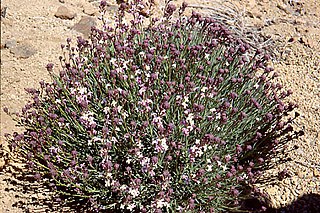
Erysimum, or wallflower, is a genus of flowering plants in the cabbage family, Brassicaceae. It includes more than 150 species, both popular garden plants and many wild forms. The genus Cheiranthus is sometimes included here in whole or in part. Erysimum has since the early 21st century been ascribed to a monogeneric cruciferous tribe, Erysimeae, characterised by sessile, stellate (star-shaped) and/or malpighiaceous (two-sided) trichomes, yellow to orange flowers and multiseeded siliques.

Erysimum mediohispanicum is a perennial short-lived monocarpic herb found in many montane regions of eastern Spain where it is distributed between 800–2,000 m above sea level and inhabits forests, scrublands, and shrublands. It occupies two main regions in the Iberian Peninsula, one in the north and the other in the south-east. Erysimum mediohispanicum may be treated as one of a group or complex of six closely related species, or as Erysimum nevadense subsp. mediohispanicum.

Erysimum nevadense is a perennial short-lived herb endemic to the Sierra Nevada of Spain, although there are some citations in the nearby Sierra de Gádor (Almería). This wallflower occurs between 1,700 and 2,700 m above sea level in subalpine scrublands and alpine meadows. It may be treated as a narrowly circumscribed single species, one of a group or complex of six separate species, or as a more broadly circumscribed species with six subspecies.
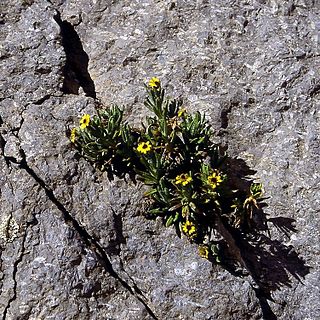
Atop of Mount Kenya Senecio keniophytum is one of the endemic groundsel (Senecio) found at high altitudes in Kenya, such as the Afro-alpine zone of Mount Kenya, but not one of the giant Dendrosenecio that also live there.
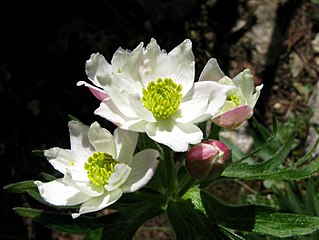
Anemonastrum narcissiflorum, the narcissus anemone or narcissus-flowered anemone, is a herbaceous perennial in the genus Anemonastrum and the buttercup family. Basionym: Anemone narcissiflora Hook. & Arn.

Erysimum capitatum is a species of wallflower known commonly as the sanddune wallflower, western wallflower, or prairie rocket.
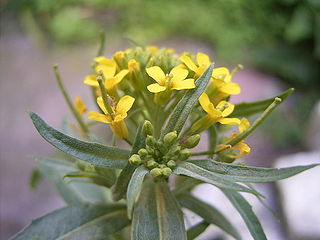
Erysimum cheiranthoides, the treacle-mustard,wormseed wallflower, or wormseed mustard is a species of Erysimum native to most of central and northern Europe and northern and central Asia. Like other Erysimum species, E. cheiranthoides accumulates two major classes of defensive chemicals, glucosinolates and cardiac glycosides.
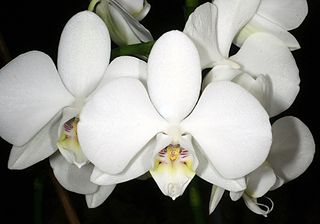
Phalaenopsis amabilis, commonly known as the moon orchid or moth orchid in India and as anggrek bulan in Indonesia, is a species of flowering plant in the orchid family Orchidaceae. It is native to the East Indies and Australia, and widely cultivated as a decorative houseplant. It is an epiphytic or lithophytic herb with long, thick roots, between two and eight thick, fleshy leaves with their bases hiding the stem and nearly flat, white, long-lasting flowers on a branching flowering stem with up to ten flowers on each branch.

Erysimum cheiri, syn. Cheiranthus cheiri, the wallflower, is a species of flowering plant in the family Brassicaceae (Cruciferae), native to Greece, but widespread as an introduced species elsewhere. It is also treated as a hybrid under the name Erysimum × cheiri. It is widely cultivated as a garden plant.

Erysimum repandum is a species of Erysimum known by several common names, including spreading wallflower, spreading treacle-mustard, and bushy wallflower.

Dracophyllum secundum is a prostrate to semi-erect shrub found in eastern Australia. It occurs from as far south as Pigeon House Mountain north to Kendall, New South Wales on the mid north coast. A common plant in the Blue Mountains near Sydney. Found as far west as Blackheath. It is often noticed by bushwalkers for the attractive flowers and arching foliage.

Betula alnoides is a species of birch that can be found in natural condition of such countries as Bangladesh, Bhutan, Cambodia, China, India, Laos, Myanmar, Nepal, Thailand and Vietnam at an elevation of 300–2,100 metres (980–6,890 ft) and higher in some cases. The southernmost of all known birch species, whose natural range reaches approximately 12° N in Cardamom Mountains, Cambodia.

Hakea cucullata, commonly known as hood-leaved hakea, cup hakea or scallop hakea, is a species of shrub in the family Proteaceae and is endemic to the south-west of Western Australia. An attractive shrub with unusual distinctive foliage and beautiful large pink, red or deep purple scented flowers.

Conospermum caeruleum, commonly known as blue brother, is a shrub in the family Proteaceae and is endemic to the south west of Western Australia. It is a prostrate shrub with small, dense heads of blue, rarely pink flowers and usually grows in heavy soils subject to flooding.
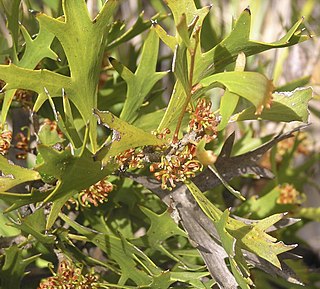
Hakea ceratophylla, commonly known as the horned leaf hakea, is a shrub in the family) Proteaceae and is endemic to the southwest of Western Australia. It is a stiff shrub with variably-shaped leaves that are sometimes lobed and flowers with white or rusty-coloured hairs.

Hakea collina is a shrub in the Proteaceae native to eastern Australia. A small many branched shrub with gnarled branches with attractive cream-yellowish flowers.

Hakea ednieana, commonly known as Flinders Range hakea or yandena, is a shrub of the Proteacea family native to arid parts of central Australia.
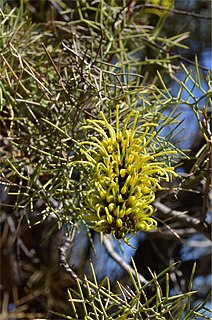
Hakea divaricata, commonly known as needlewood, corkbark tree or fork-leaved corkwood, is a tree or shrub in the family Proteaceae native to an area in central Australia. A slow growing species with up to 120 showy cream to greenish-yellow flowers in long racemes from June to November.

Hakea nitida, commonly called the frog hakea or shining hakea, is a shrub of the family Proteaceae and is endemic to an area in the southern Wheatbelt, Great Southern and Goldfields-Esperance regions of Western Australia.
Grevillea pauciflora, commonly known as the few-flowered grevillea, is a shrub of the genus Grevillea native to an area along the south coast in the Great Southern and Goldfields-Esperance regions of Western Australia.




















